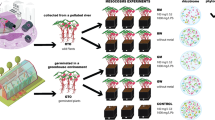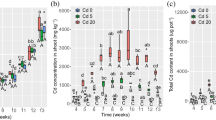Abstract
Aims
Recent research on the rhizosphere microbiome indicates that plants may benefit more from microbial communities than from individual members in a community. The link between soil microbiome and plant performance remains poorly understood during trace metal phytoremediation by hyperaccumulator plants. The effect of different microbiomes on the cadmium (Cd)/zinc (Zn) phytoextraction efficiency of Sedum plumbizincicola was therefore explored.
Methods
Different microbiomes were set up using γ-irradiation and vancomycin addition and a pot experiment was conducted. The microbial communities were characterized using high-throughput sequencing and their functions were predicted.
Results
Plant Cd and Zn contents in the vancomycin-amended treatment were about 38–46% and 35%–53% respectively lower than those in the other treatments. Bacterial composition and diversity were substantially changed by γ-irradiation and vancomycin addition but plant trace metal accumulation did not change subsequently. The bacterial functional profiles were very different following treatment with vancomycin compared with the other treatments at KEGG orthology hierarchy level 3. Genes related to up-regulated biofilm formation and down-regulated siderophore synthesis may partly contribute together to the low plant trace metal accumulation following vancomycin treatment.
Conclusions
Specific bacterial community function rather than bacterial community diversity and composition may affect trace metal uptake by hyperaccumulator plants.






Similar content being viewed by others
References
Anderson JM, Ingram JSI (1993) Tropical soil biology and fertility: a handbook of methods. CAB International Publishing, Wallingford
Bell TH, Yergeau E, Juck DF, Whyte LG, Greer CW (2013) Alteration of microbial community structure affects diesel biodegradation in an Arctic soil. FEMS Microbiol Ecol 85:51–61
Bell TH, Cloutier-Hurteau B, Al-Otaibi F, Turmel MC, Yergeau E, Courchesne F, St-Arnaud M (2015) Early rhizosphere microbiome composition is related to the growth and Zn uptake of willows introduced to a former landfill. Environ Microbiol 17:3025–3038
Bhargava A, Carmona FF, Bhargava M, Srivastava S (2012) Approaches for enhanced phytoextraction of heavy metals. J Environ Manag 105:103–120
Buchan D, Moeskops B, Ameloot N, Neve SD, Sleutel S (2012) Selective sterilisation of undisturbed soil cores by gamma irradiation: effects on free-living nematodes, microbial community and nitrogen dynamics. Soil Biol Biochem 47:10–13
Cabello-Conejo MI, Prieto-Fernández A, Kidd PS (2014) Exogenous treatments with phytohormones can improve growth and nickel yield of hyperaccumulating plants. Sci Total Environ 494–495: 1–8
Farinati S, Dalcorso G, Panigati M, Furini A (2011) Interaction between selected bacterial strains and Arabidopsis halleri modulates shoot proteome and cadmium and zinc accumulation. J Exp Bot 62:3433–3447
Feng MH, Shan XQ, Zhang S, Wen B (2005) A comparison of the rhizosphere-based method with DTPA, EDTA, CaCl2, and NaNO3 extraction methods for prediction of bioavailability of metals in soil to barley. Environ Pollut 137:231–240
Gadd GM (2004) Microbial influence on metal mobility and application for bioremediation. Geoderma 122:109–119
Glick BR, Penrose DM, Li J (1998) A model for the lowering of plant ethylene concentrations by plant growth-promoting bacteria. J Theor Biol 190:63–68
Gremion F, Chatzinotas A, Kaufmann K, Von SW, Harms H (2004) Impacts of heavy metal contamination and phytoremediation on a microbial community during a twelve-month microcosm experiment. FEMS Microbiol Ecol 48:273–283
Guo J, Chi J (2014) Effect of cd-tolerant plant growth-promoting rhizobium on plant growth and cd uptake by Lolium multiflorum lam. And Glycine max (L.) Merr. in Cd-contaminated soil. Plant Soil 375:205–214
Gupta P, Diwan B (2016) Bacterial exopolysaccharide mediated heavy metal removal: a review on biosynthesis, mechanism and remediation strategies. Biotechnol Rep 13:58–71
Hadi F, Bano A, Fuller MP (2010) The improved phytoextraction of lead (Pb) and the growth of maize (Zea mays L.): the role of plant growth regulators (GA3 and IAA) and EDTA alone and in combinations. Chemosphere 80:457–462
He S, He Z, Yang X, Stoffella PJ, Baligar VC (2015) Soil biogeochemistry, plant physiology, and phytoremediation of cadmium-contaminated soils. Adv Agron 134:135–225
Hou J, Liu W, Wang B, Wang Q, Luo Y, Franks AE (2015) PGPR enhanced phytoremediation of petroleum contaminated soil and rhizosphere microbial community response. Chemosphere 138:592–598
Hou D, Wang K, Liu T, Wang H, Lin Z, Qian J, Lu L, Tian S (2017) Unique rhizosphere micro-characteristics facilitate phytoextraction of multiple metals in soil by the hyperaccumulating plant Sedum alfredii. Environ Sci Technol 51:5675–5684
Huh Y, Kim I, Lee K (2015) Effect of biocide addition on plantlet growth and contamination occurrence during the in vitro culture of blueberry. J Plant Biotechnol 42:111–116
Jia T, Cao M, jing J, Liu J, Chai B (2017) Endophytic fungi and soil microbial community characteristics over different years of phytoremediation in a copper tailings dam of Shanxi, China. Sci Total Environ 574:881
Jiang J, Wu L, Li N, Luo Y, Liu L, Zhao Q, Zhang L, Christie P (2010) Effects of multiple heavy metal contamination and repeated phytoextraction by Sedum plumbizincicola on soil microbial properties. Eur J Soil Biol 46:18–26
Krumins JA, Goodey NM, Gallagher F (2015) Plant-soil interactions in metal contaminated soils. Soil Biol Biochem 80:224–231
Laghlimi M, Baghdad B, Hadi HE, Bouabdli A (2015) Phytoremediation mechanisms of heavy metal contaminated soils: a review. Open. J Ecol 5:375–388
Lal R (2006) Encyclopedia of soil science. CRC Press, Boca Raton
Lampis S, Santi C, Ciurli A, Andreolli M, Vallini G (2015) Promotion of arsenic phytoextraction efficiency in the fern Pteris vittata by the inoculation of as-resistant bacteria: a soil bioremediation perspective. Front Plant Sci 6:80
Langille MGI, Zaneveld J, Caporaso JG, Mcdonald D, Dan K, Reyes JA, Clemente JC, Burkepile DE, Thurber RLV, Knight R (2013) Predictive functional profiling of microbial communities using 16S rRNA marker gene sequences. Nat Biotechnol 31:814
Li JT, Liang ZW, Jia P, Liu J, YJ X, Chen YJ, Shu HY, Kuang JL, Liao B, Shu WS (2017) Effects of a bacterial consortium from acid mine drainage on cadmium phytoextraction and indigenous soil microbial community. Plant Soil 415:1–12
Liu W, Wang Q, Wang B, Hou J, Luo Y, Tang C, Franks AE (2015) Plant growth-promoting rhizobacteria enhance the growth and cd uptake of Sedum plumbizincicola in a cd-contaminated soil. J Soils Sediments 15:1191–1199
Lu R (2000) Analytical methods for soil and agrochemistry. Agricultural Science and Technology Press, Beijing
McNamara N, Black H, Beresford N, Parekh N (2003) Effects of acute gamma irradiation on chemical, physical and biological properties of soils. Appl Soil Ecol 24:117–132
Mudawi E, Cornelia G, Ivo F, Andrea P (2012) Cadmium interferes with auxin physiology and lignification in poplar. J Exp Bot 63:1413–1421
Muehe EM, Weigold P, Adaktylou IJ, Planer-Friedrich B, Kraemer U, Kappler A, Behrens S (2015) Rhizosphere microbial community composition affects cadmium and zinc uptake by the metal-hyperaccumulating plant Arabidopsis halleri. Appl Environ Microbiol 81:2173–2181
Niba ETE, Naka Y, Nagase M, Mori H, Kitakawa M (2007) A genome-wide approach to identify the genes involved in biofilm formation in E. coli. DNA Res 14:237–246
Perera PACT, Kodithuwakku SP, Sundarabarathy TV, Edirisinghe U (2015) Bioaccumulation of cadmium in freshwater fish: an environmental perspective. Insight Ecol 4:1–12
Prapagdee B, Chanprasert M, Mongkolsuk S (2013) Bioaugmentation with cadmium-resistant plant growth-promoting rhizobacteria to assist cadmium phytoextraction by Helianthus annuus. Chemosphere 92:659–666
Rajkumar M, Ae N, Prasad MN, Freitas H (2010) Potential of siderophore-producing bacteria for improving heavy metal phytoextraction. Trends Biotechnol 28:142–149
Rajkumar M, Sandhya S, Prasad MNV, Freitas H (2012) Perspectives of plant-associated microbes in heavy metal phytoremediation. Biotechnol Adv 30:1562–1574
Rubin RL, van Groenigen KJ, Hungate BA (2017) Plant growth promoting rhizobacteria are more effective under drought: a meta-analysis. Plant Soil 416:309–323
Seneviratne M, Seneviratne G, Madawala H, Vithanage M (2017) Role of rhizospheric microbes in heavy metal uptake by plants. Springer International Publishing, Cham
Tang X, Li Q, Wu M, Lin L, Scholz M (2016) Review of remediation practices regarding cadmium-enriched farmland soil with particular reference to China. J Environ Manag 181:646–662
Thijs S, Sillen W, Rineau F, Weyens N, Vangronsveld J (2016) Towards an enhanced understanding of plant–microbiome interactions to improve phytoremediation: engineering the metaorganism. Front Microbiol 7:341
Wood JL, Liu W, Tang C, Franks AE (2016a) Microorganisms in heavy metal bioremediation: strategies for applying microbial-community engineering to remediate soils. AIMS Bioeng 3:211–229
Wood JL, Tang C, Franks AE (2016b) Microbial associated plant growth and heavy metal accumulation to improve phytoextraction of contaminated soils. Soil Biol Biochem 103:131–137
Wu CH, Wood TK, Mulchandani A, Chen W (2006) Engineering plant-microbe symbiosis for rhizoremediation of heavy metals. Appl Environ Microbiol 72:1129–1134
Wu LH, Liu YJ, Zhou SB, Guo FG, Bi D, Guo XH, Baker AJM, Smith JAC, Luo YM (2013) Sedum plumbizincicola X.H. Guo et S.B. Zhou ex L.H. Wu (Crassulaceae): a new species from Zhejiang Province, China. Plant Syst Evol 299:487–498
Acknowledgements
This research was supported by the National Natural Science Foundation of China (41230858, 41325003), the Key Projects in the National Science and Technology Pillar Program (2015BAD05B04) and the Science and Technology Program of Jiangsu, China (SBK2014043721).
Author information
Authors and Affiliations
Corresponding author
Additional information
Responsible Editor: Antony Van der Ent.
Rights and permissions
About this article
Cite this article
Hou, J., Liu, W., Wu, L. et al. Modulation of the efficiency of trace metal phytoremediation by Sedum plumbizincicola by microbial community structure and function. Plant Soil 421, 285–299 (2017). https://doi.org/10.1007/s11104-017-3466-8
Received:
Accepted:
Published:
Issue Date:
DOI: https://doi.org/10.1007/s11104-017-3466-8




